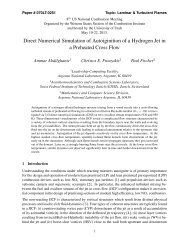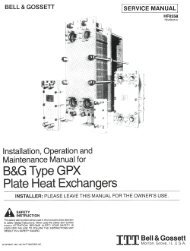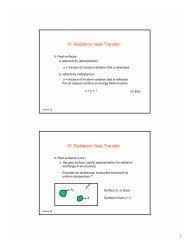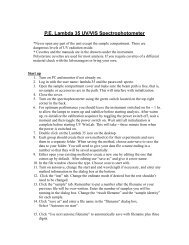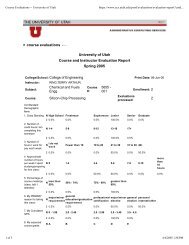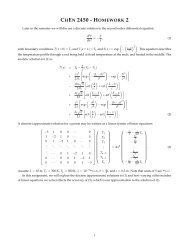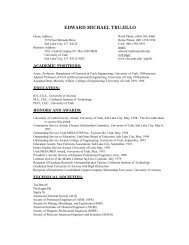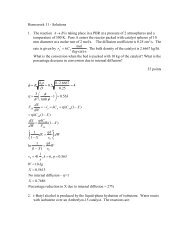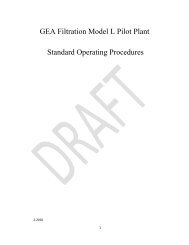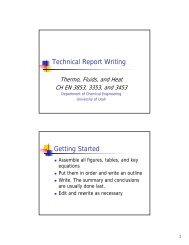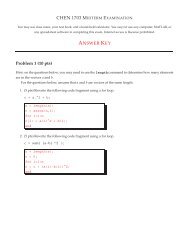HYDRA CELL Manuale Uso e Manutenzione ... - Asco Pompe Srl
HYDRA CELL Manuale Uso e Manutenzione ... - Asco Pompe Srl
HYDRA CELL Manuale Uso e Manutenzione ... - Asco Pompe Srl
- No tags were found...
Create successful ePaper yourself
Turn your PDF publications into a flip-book with our unique Google optimized e-Paper software.
D/G-10 InstallationInlet Piping (Suction Feed)CAUTION: When pumping at temperatures above 160° F(71° C), use a pressure-feed system.Install draincocks at any low points of the suction line, to permitdraining in freezing conditions.Provide for permanent or temporary installation of a vacuumgauge to monitor the inlet suction. To maintain maximum flow,vacuum at the pump inlet should not exceed 7 in. Hg at 70° F(180 mm Hg at 21° C). Do not supply more than one pumpfrom the same inlet line.Supply TankUse a supply tank that is large enough to provide time for anytrapped air in the fluid to escape. The tank size should be atleast twice the maximum pump flow rate.Isolate the pump and motor stand from the supply tank, andsupport them separately.Install a separate inlet line from the supply tank to each pump.Install the inlet and bypass lines so they empty into the supplytank below the lowest water level, on the opposite side of thebaffle from the pump suction line.If a line strainer is used in the system install it in the inlet line tothe supply tank.To reduce aeration and turbulence, install a completelysubmerged baffle plate to separate the incoming and outgoingliquids.Install a vortex breaker in the supply tank, over the outlet portto the pump.Place a cover over the supply tank, to prevent foreign objectsfrom falling into it.Hose and RoutingSize the suction line at least one size larger than the pumpinlet, and so that the velocity will not exceed 1-3 ft/sec (0.3 to0.9 m/s):For pipe in inches: Velocity (ft/sec) = 0.408 x GPM/Pipe ID 2For pipe in mm: Velocity (m/sec) = 21.2 x LPM/Pipe ID 2Keep the suction line as short and direct as possible. A maximumof 3 feet (1 m) is recommended.Use flexible hose and/or expansion joints to absorb vibration,expansion, or contraction.If possible, keep the suction line level. Do not have any highpoints to collect vapor unless these high points are vented.To reduce turbulence and resistance, do not use 90° elbows. Ifturns are necessary in the suction line, use 45° elbows orarrange sweeping curves in the flexible inlet hose.If a block valve is used, be sure it is fully opened so that theflow to the pump is not restricted. The opening should be atleast the same diameter as the inlet plumbing ID.Do not use a line strainer or filter in the suction line unlessregular maintenance is assured. If used, it should have a freeflowarea of at least three times the free-flow area of the inlet.Install piping supports where necessary to relieve strain on theinlet line and to minimize vibration.Loctite is a registered trademark of Loctite Corporation.Teflon is a registered trademark of E. I. DuPont de Nemours & Co. Inc.Scotchbrite is a registered trademark of 3M Company.Inlet Piping (Pressure Feed)Provide for permanent or temporary installation of a vacuum/pressure gauge to monitor the inlet vacuum or pressure.Pressure at the pump inlet should not exceed 250 psi (17 bar);if it could get higher, install an inlet pressure reducing regulator.Do not supply more than one pump from the same inlet line.Inlet CalculationsAcceleration HeadCalculating the Acceleration HeadUse the following formula to calculate acceleration head losses.Subtract this figure from the NPSHa, and compare the result tothe NPSHr of the Hydra-Cell pump.Ha = (L x V x N x C) ÷ (K x G)where:Ha = Acceleration head (ft of liquid)L = Actual length of suction line (ft) — not equivalent lengthV = Velocity of liquid in suction line (ft/sec) [V = GPM x (0.408÷ pipe ID 2 )]N = RPM of crank shaftC = Constant determined by type of pump — use 0.066 forthe D-10 and G-10 Hydra-Cell pumpsK = Constant to compensate for compressibility of the fluid— use: 1.4 for de-aerated or hot water; 1.5 for mostliquids; 2.5 for hydrocarbons with high compressibilityG = Gravitational constant (32.2 ft/sec 2 )Friction LossesCalculating Friction Losses in Suction PipingWhen following the above recommendations (under “InletPiping”) for minimum hose/pipe I.D. and maximum length,frictional losses in the suction piping are negligible (i.e., Hf = 0)if you are pumping a water-like fluid.When pumping more-viscous fluids such as lubricating oils,sealants, adhesives, syrups, varnishes, etc., frictional lossesin the suction piping may become significant. As Hf increases, theavailable NPSH (NPSHa) will decrease, and cavitation will occur.In general, frictional losses increase with increasing viscosity,increasing suction-line length, increasing pump flowrate, anddecreasing suction-line diameter. Changes in suction-linediameter have the greatest impact on frictional losses: a 25%increase in suction-line diameter cuts losses by more than twotimes, and a 50% increase cuts losses by a factor of five times.Consult the factory before pumping viscous fluids.Minimizing Acceleration Head and Frictional LossesTo minimize the acceleration head and frictional losses:• Keep inlet lines less than 3 ft (1 m) long• Use at least 1-1/2 in. (38 mm) I.D. inlet hose• Use soft hose (low-pressure hose, noncollapsing) for theinlet lines• Minimize fittings (elbows, valves, tees, etc.)• Use a suction stabilizer on the inlet.6 D10-991-2400 5/1/04



